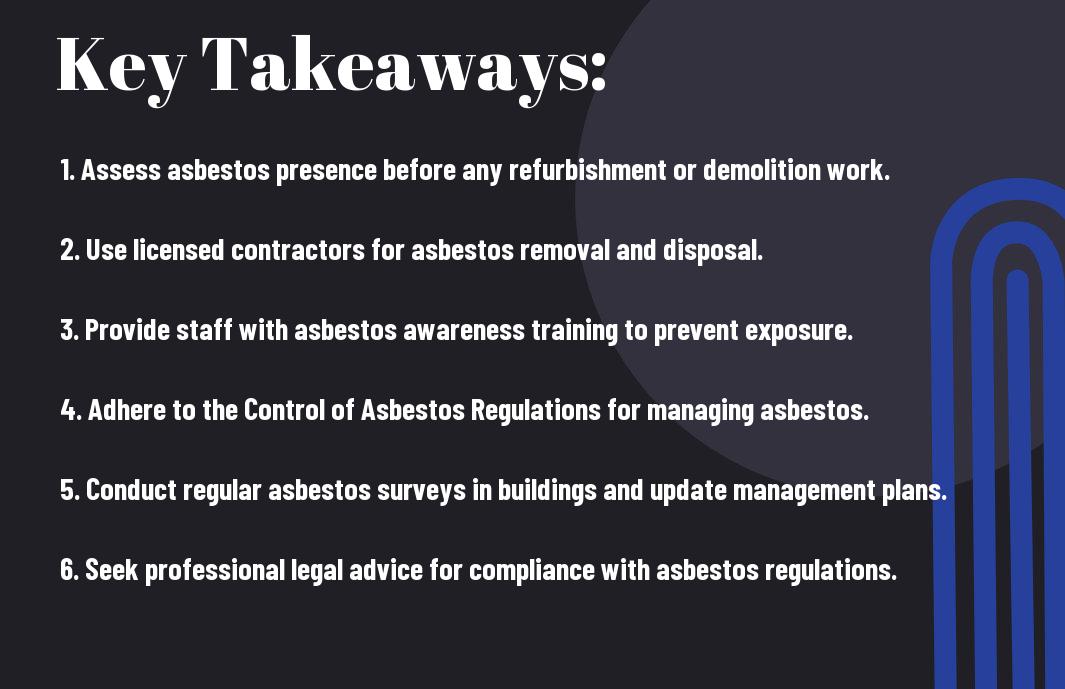Asbestos, a potentially hazardous material often found in older buildings, poses a serious health risk if not handled properly. In this informative blog post, we will discuss safety and legal guidelines for dealing with asbestos to ensure the protection of yourself and others. It is crucial to understand the dangers associated with asbestos exposure, as well as the legal obligations for managing and removing it.
Key Takeaways:
- Safety first: When dealing with asbestos, it is crucial to prioritise safety for both workers and the public. Always follow proper safety protocols and guidelines to avoid exposure and health risks.
- Legal compliance: It is essential to adhere to all legal regulations and guidelines when working with asbestos. This includes obtaining the necessary permits and licenses, as well as ensuring proper disposal of asbestos-containing materials.
- Professional assistance: Given the dangers associated with asbestos, it is advisable to seek help from qualified and experienced professionals for handling, removal, and disposal of asbestos. DIY approaches are not recommended due to the high risk involved.

Identifying Asbestos Risks
Asbestos is a hazardous material that can be found in many older buildings and homes. It is crucial to be able to identify asbestos risks in order to ensure the safety of occupants and workers. Understanding the common sources of asbestos and the associated health risks is essential in preventing exposure and related illnesses.
Locations and Materials Commonly Containing Asbestos
Asbestos can be found in various locations and materials, including but not limited to insulation, ceiling tiles, floor tiles, roofing materials, and textured coatings such as Artex. When disturbed or damaged, these materials can release asbestos fibres into the air, posing a significant health risk to anyone nearby. It is important to be aware of these common sources of asbestos and to take appropriate precautions when dealing with them.
Health Risks Associated With Asbestos Exposure
Exposure to asbestos fibres can lead to severe health issues, including lung cancer, asbestosis, and mesothelioma. These diseases can develop years after the initial exposure, making it crucial to take preventive measures and seek medical attention if there is any suspicion of exposure. It is essential to understand the health risks associated with asbestos exposure in order to protect oneself and others from potential harm.

Legal Framework for Asbestos Management
When it comes to dealing with asbestos, it is crucial to have a solid understanding of the legal framework surrounding its management. This includes the regulations set by both federal and state authorities, as well as the responsibilities of property owners and employers in ensuring the safety of their premises and workers.
To gain a comprehensive insight into the legal guidelines for asbestos management, it is essential to refer to the official documents provided by reputable sources. The Asbestos: Worker and Employer Guide to Hazards And … published by the National Institute of Environmental Health Sciences (NIEHS) offers valuable insights into the legal framework for managing asbestos in the workplace.
Federal and State Regulations
Both federal and state governments have set stringent regulations to govern the management of asbestos. The Control of Asbestos Regulations 2012 in the UK, for example, outlines the responsibilities of employers and building owners in managing asbestos risks. Meanwhile, the Environmental Protection Agency (EPA) in the United States enforces the Asbestos Hazard Emergency Response Act (AHERA) and the Asbestos School Hazard Abatement Reauthorization Act (ASHARA) to regulate the management of asbestos in educational institutions.
Responsibilities of Property Owners and Employers
Property owners and employers have a legal obligation to ensure the safety of their premises and workers by effectively managing asbestos risks. This includes conducting regular asbestos surveys, implementing appropriate control measures, providing adequate training to employees, and maintaining accurate records of asbestos-containing materials (ACMs) on their premises. Failure to comply with these legal requirements can result in severe penalties and legal consequences, making it imperative for property owners and employers to prioritise asbestos management.
It is important for property owners and employers to collaborate with qualified asbestos professionals to conduct surveys, manage risks, and carry out any necessary abatement or removal procedures. By engaging experts in the field, property owners and employers can ensure that their legal obligations are met while safeguarding the well-being of occupants and workers.

Safe Handling and Removal Procedures
When it comes to dealing with asbestos, it is essential to adhere to safe handling and removal procedures to protect yourself and others from the harmful effects of asbestos exposure. The Occupational Safety and Health Administration (OSHA) has set regulations and guidelines for asbestos handling and removal, which can be found in the 1926.1101 – Asbestos | Occupational Safety and Health document. It is crucial to familiarise yourself with these regulations before undertaking any asbestos-related work.
Certified Asbestos Professionals
When it comes to handling and removing asbestos, it is imperative to hire certified asbestos professionals who have the necessary training and expertise. These professionals are equipped to assess, contain, and remove asbestos safely, ensuring minimal risk of exposure to you and others. It is illegal for untrained individuals to carry out asbestos removal work. By enlisting the services of certified asbestos professionals, you can be assured that the removal process will be carried out in accordance with the law and industry standards.
Steps for Safe Asbestos Removal and Disposal
Safe asbestos removal and disposal involve a series of meticulous steps to ensure the protection of workers and the public. Proper containment and removal procedures are crucial to prevent the spread of asbestos fibres, which can pose serious health risks when inhaled. Steps may include sealing off the work area, wearing protective clothing, using specialized equipment for handling asbestos, and appropriately disposing of asbestos waste in designated facilities.
It is essential to engage in safe asbestos removal and disposal practices to prevent the release of asbestos fibres into the environment. Strict adherence to safety procedures and regulations is paramount to minimising the health hazards associated with asbestos exposure.
Asbestos in Emergencies and Natural Disasters
During emergencies and natural disasters, the risk of asbestos exposure can increase due to the disturbance of asbestos-containing materials. It is essential to be aware of the potential dangers and legal guidelines regarding asbestos in such situations. For detailed information on asbestos laws and regulations, you can refer to the Asbestos Laws and Regulations provided by the US EPA.
Responding to Asbestos Exposure Post-Disaster
In the aftermath of a natural disaster, individuals may have been exposed to asbestos fibres, leading to potential health risks. It is crucial to seek medical attention and report any suspected asbestos-containing materials to the relevant authorities. Immediate action is necessary to prevent further exposure and ensure proper handling of asbestos debris.
Mitigation Strategies and Restoration
Once the immediate danger has passed, mitigation strategies for asbestos contamination must be implemented. Professional asbestos removal and disposal services should be engaged to restore the affected areas. Thorough cleaning and decontamination are essential to ensure the safety of the environment and prevent future health hazards.
Do not attempt to handle asbestos-containing materials without proper protective equipment and training. Engaging certified professionals for asbestos mitigation and restoration is crucial for ensuring effective and safe procedures.
Dealing with Asbestos – Safety and Legal Guidelines
In conclusion, it is imperative to adhere to safety and legal guidelines when dealing with asbestos. Asbestos exposure can lead to serious health issues such as lung diseases and cancer, making it crucial to handle it with utmost care. By following the appropriate safety measures and legal regulations, individuals and businesses can protect themselves and others from the dangerous effects of asbestos. It is also important to stay updated with the latest regulations and guidelines to ensure compliance with the law and to maintain a safe environment for all. Ultimately, prioritising safety and legal compliance when dealing with asbestos is not only imperative for health and well-being, but also for preventing any potential legal consequences. Therefore, by being vigilant and responsible in our approach to asbestos, we can safeguard against its harmful impact and contribute to creating a safer working and living environment for everyone.
Dealing with Asbestos – Safety and Legal Guidelines FAQ
Q: What is asbestos?
A: Asbestos is a naturally occurring mineral that was commonly used in construction materials due to its heat resistance and strength. However, it is now known to be a health hazard when its fibres are released into the air and inhaled.
Q: How can asbestos exposure affect my health?
A: Asbestos exposure can lead to serious health issues such as lung cancer, mesothelioma, and asbestosis. These diseases often have a long latency period, meaning symptoms may not appear for decades after exposure.
Q: What safety precautions should be taken when dealing with asbestos?
A: It is crucial to assess the risk of asbestos exposure before starting any work. Personal protective equipment, such as respiratory protective equipment and disposable coveralls, should be worn at all times. Additionally, work should be carried out by trained and competent professionals to minimise the risk of fibre release.
Q: Are there legal guidelines for dealing with asbestos?
A: Yes, there are strict legal regulations in place for working with asbestos. This includes the Control of Asbestos Regulations 2012, which outlines the responsibilities of employers and employees when working with asbestos-containing materials. Failure to comply with these regulations can result in serious penalties.
Q: How should asbestos waste be disposed of?
A: Asbestos waste must be disposed of in accordance with the Hazardous Waste Regulations. It should be double-bagged in heavy-duty polythene and clearly labelled as asbestos waste. Additionally, it must be transported and disposed of by a licensed waste carrier at a designated hazardous waste site.







